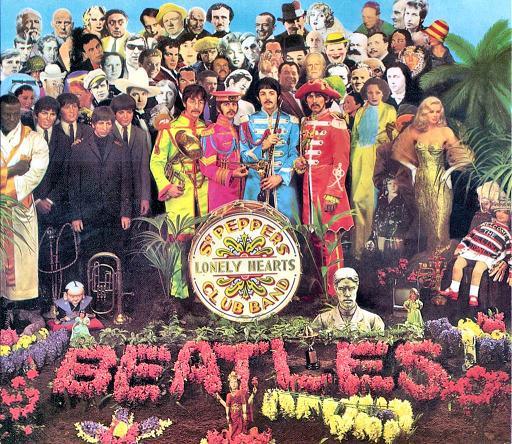Peter Blake (artist)
|
|
This article is not about the late New Zealand yachtsman, Sir Peter Blake.
Sir Peter Blake (born June 25, 1932) is a British artist, perhaps best known among the general public for his design of the sleeve for The Beatles' album Sgt. Pepper's Lonely Hearts Club Band.
Blake was born in Dartford, Kent into a lower-middle class family; his early childhood was largely commonplace. The outbreak of World War II impacted Peter Blake’s youth to a large extent as he was evacuated from his hometown and this situation coupled with the wartime resource rationing and economic conditions resulted in a profound effect upon the subject matter within Blake’s later works. The economy in Britain did not improve during the post-war period and a policy of peacetime conscription took form in between 1945 and 1963. Blake was part of a generation that would be deeply affected in the post-war situation as young men were required to serve in the military; subsequently the high cost of training conscripts, resources for the military and the redirection of the young male workforce contributed to the decline of the British economy. Blake studied at the Gravesend School of Art, and then the Royal College of Art from 1953 to 1956 following his time in the national service, where his contemporaries included Bridget Riley and Frank Auerbach. He graduated in 1956 and returned there to teach from 1964 to 1976. One of the students he encouraged was Ian Dury, who remained a friend. He also studied folk art throughout Europe, and from 1951 to 1953 he served in the Royal Air Force.
Around the late 1950s, Blake became one of the best known British pop artists, making a number of paintings including imagery from advertisements, music hall entertainment, wrestlers (in The Masked Zebra Kid (1965), for example) and so on. Many of these works include collaged elements. He first came to public attention when he featured in Ken Russell's film on pop art, Pop Goes the Easel, which was broadcast on BBC television.
On the Balcony (1955-57) is a significant early work and still stands as one of the iconic pieces of British Pop Art, showing Blake's interest in combining images from pop culture with fine art. The work, which appears to be a collage but is in fact wholly painted, shows, among other things, a boy holding Edouard Manet's The Balcony, badges and magazines. It was inspired by a painting by Honoré Sharrer depicting workers holding famous paintings. Blake confronts the viewer with a picture plane that is deceptively flat, effectively blocking the viewer from venturing deeper into the picture plane. This spatial property however is a flatness that resounds starkly; a flat surface that at once becomes a presentation of characters and images as well as a culturally implicit sense of external facade. One of the most striking initial aspects of this piece is that it seems to radiate an illusionist child-like charm which the viewer can easily identify with making it from first glance an oddly powerful work. His self-identification with the axioms of popular culture in effect show an awareness of the mechanisms of a society being faced with celebrity idolatry and cultural goods. Such banal goods and images were not frequently seen in artwork and created a new space for discourse within a painting. Blake’s characters are strangely static and scarcely seem to notice the accumulation around them – even when images are tacked right on top of them. This was not merely whimsical thinking or dreams of consumer grandeur, and albeit not a simple display of products; it was life as Blake experienced it, as true and telling an account of the surroundings of the time as could be made. He showed an awareness of the nature of the celebrity and a responsiveness to the increasing persistence of influence – a rapid bombardment of cultural imagery. The children are depicted with accumulated images and cultural goods, calling into mind the escalating impact of these figures and symbols.
Another piece to refer to the work of other artists is The First Real Target (1961). This is a real archery target, stuck to a board with the title of the work written across the top. It refers to the paintings of targets made by Kenneth Noland and Jasper Johns.
 |
As well as the sleeve for Sgt. Pepper's Lonely Hearts Club Band (1967, shown to the right), Blake also made sleeves for the Band Aid single, "Do They Know It's Christmas?" (1984), Paul Weller's Stanley Road (1995) and the Ian Dury tribute album Brand New Boots and Panties (2001). He also designed the sleeve for The Who's Face Dances (1981), which features portraits of the band by a number of artists. In the early 1970s, he made a set of watercolours to illustrate Lewis Carroll's Through the Looking Glass.
Blake was made a Royal Academician in 1981, a CBE in 1983, and in 2002 was knighted.
External links
- Blake at the Tate Gallery (http://www.tate.org.uk/servlet/ArtistWorks?cgroupid=999999961&artistid=763&page=1) (includes a biography, and images of several of his works)
- Jonathon Jones of The Guardian writing about Blake's Self-Portrait With Badges (1961) (http://www.guardian.co.uk/arts/portrait/story/0,11109,740373,00.html)fr:Peter Blake (artiste)
